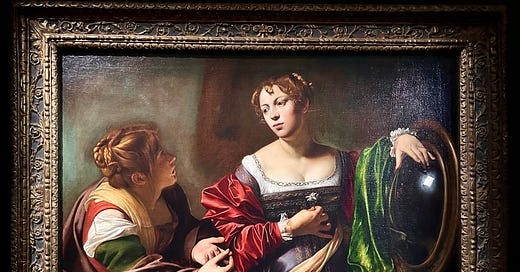In my last post, I left the blockbuster Caravaggio show at Palazzo Barberini in the second room with a pair of portraits of Maffeo Barberini—the earlier of the two is attributed to Caravaggio; the second considered an autograph work—who would become Pope Urban VIII.
If these portraits of the go-getting young prelate are a rare examples in Caravaggio’s oeuvre of official portraiture, the same room is home to three examples of a rather more informal sort of portraiture, that of one of his favoured models believed to be Filide Melandroni. The identification of Filide comes from Caravaggio’s portrait of her which was destroyed in Berlin towards the end of the Second World War. Filide was a courtesan originally from Siena where she was born in 1581. If, as is believed, it is she who features in these paintings, she was perhaps seventeen when she came to Caravaggio’s attention. Certainly the same face features in the Martha and Mary Magdalene (here on loan from Detroit), the Judith and Holofernes (in the permanent collection of Palazzo Barberini), and the Catherine of Alexandria (which has travelled from the Thyssen-Bornemisza in Madrid).
The Martha and Mary painted, like the second portrait of Maffeo, c.1598 when Caravaggio was living in the Palazzo Madama as part of the retinue of Cardinal Del Monte takes its cue from a tale narrated only in the book of Luke. Martha and Mary are sisters who welcome Jesus into their home at Bethany. While Martha was busy serving, Mary sat at Christ’s feet listening to his teachings. The message of the story is that spiritual contemplation should triumph over service. I always imagine Martha as more than a little disgruntled, after all the laundry won’t do itself I hear her mutter. In Caravaggio’s version the Mary of this story is identified with Mary Magdalene, following a medieval divergence from the gospel.
In Caravaggio’s interpretation we see Martha, her face turned from the viewer, earnestly engaged in converting Mary, who holds an orange blossom to her bosom, away from earthly pleasures: the mirror, comb, the dish of cosmetics. The identification of Mary of Bethany here as Mary Magdalene offers Caravaggio the opportunity to contrast the two: the opulence of the billowing red silk of Mary’s sleeve with Martha’s dull dress; Mary’s crisp ringlets with Martha’s dishevelled hair. Mary’s left hand rests on the convex mirror, a symbol of the vanities she is in the process of renouncing.
Keep reading with a 7-day free trial
Subscribe to Understanding Rome's Newsletter to keep reading this post and get 7 days of free access to the full post archives.






